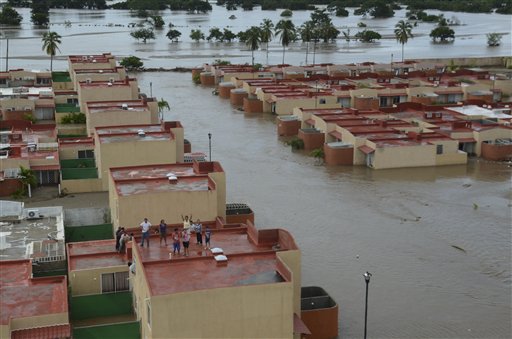ACAPULCO, Mexico - The death toll rose to 47 Tuesday from the unusual one-two punch of a tropical storm and a hurricane hitting Mexico at nearly the same time. Authorities scrambled to get help into, and stranded tourists out of, the cutoff resort city of Acapulco.
With roads blocked by landslides, rockslides, floods and collapsed bridges, Acapulco was cut off from road transport after Tropical Storm Manuel made landfall on Sunday. The terminal at the city's international airport was flooded, but not the landing strips.
Emergency flights began arriving in Acapulco to evacuate at least 40,000 mainly Mexican tourists stranded in the resort city where some streets were transformed into raging brown rivers. .
Interior Secretary Miguel Angel Osorio Chong told the Radio Formula that 27 people had died because of the storm in the Pacific coast state of Guerrero, where Acapulco is located. Osorio Chong said 20 more people died nationwide, many as a result of former hurricane Ingrid, which struck the Gulf coast on Monday. Mexican meteorologists said it was the first time since 1958 that two tropical storms or hurricanes had hit both the country's coasts within 24 hours.
While most Acapulco hotels seemed to be operating normally on Tuesday, many outlying neighborhoods were without water or electricity, and floodwaters were knee-deep at the city airport's check-in counters.
Federal officials said it could take at least another two days to open the main highway to Acapulco, which was hit by more than 13 landslides from surrounding hills, and to bring food and relief supplies into the city of more than 800,000 people.
Two of Mexico's largest airlines, Aeromexico and Interjet, began running flights to and from the still-swamped international airport. Those with tickets got first priority, then families with small children or elderly members, officials said.
Interjet's director Luis Jose Garza told Milenio TV that his airline's first flight was taking 150 passengers back to Mexico City and it hoped to run four to six such flights Tuesday.
Guerrero state's government said 40,000 tourists were stuck in the city, but the head of the local chamber of business owners said reports from hotels indicated the number could be as high as 60,000.
Thousands of stranded tourists lined up outside an air force base north of Acapulco to try to get a seat on one of a handful of planes flying to Mexico City. Many said they've been waiting at the base for hours after they were unable to return to Mexico City by road.
Gavin McLoughlin, 27, a teacher at Mexico City's Greengates School, said he went to Acapulco on a late night bus Thursday with about 30 other teachers at the school, many of whom are in their 20s.
"We had no idea of the weather," the Englishman said. "We knew there was a hurricane on the other side but not this side."
They group was staying at the Copacabana Hotel and by Sunday they were unable to leave the hotel because of the rain.
The main coastal boulevard was open Tuesday and most hotels appeared to have power, water and food. But that was little consolation to those unable to leave Acapulco.
"It's probably one of the worst holidays I've ever been on," said David Jefferson Gled, a 28-year-old English teacher at Greengates School. "It wasn't really a holiday, more of an incarceration."
Military officials said there would be 17 flights on Tuesday. Nine planes and five helicopters shuttling back and forth between Mexico City and this air force base.
The situation was far more serious in the city's low-income periphery, where steep hills funneled rainwater into neighborhoods of cinderblock houses.
City officials said about 23,000 homes, mostly on Acapulco's outskirts, were without electricity and water. Stores were nearly emptied by residents who rushed to stock up on basic goods. Landslides and flooding damaged an unknown number of homes.
Natividad Gallegos said she returned Monday from shopping to find her house in a poor Acapulco neighborhood buried by a landslide that killed six members of her family, including her two children. "I saw a lot of strangers with picks and shovels, digging where my house used to be," she said, weeping.
The coastal town of Coyuca de Benitez and beach resorts further west of Acapulco, including Ixtapa and Zihuatenejo, were cut off after a river washed out a bridge on the main coastal highway.
Marcela Higuera, who runs a bread stall in the Coyuca market, said the only aid that had arrived so far was a helicopter that rescued stranded flood victims.
"Flour's already run out. There isn't any in Coyuca," she said, adding that the Coyuca River had swept away the bridge and riverside restaurants, and flooded low-lying neighborhoods. "This is the worst storm that I've seen."
"There are hundreds of people in shelters and they're begging for clothes and blankets because everything they have is wet," Higuera said. "They had to leave without taking anything."
Remnants of Manuel continued to drench Mexico further up the Pacific coast and the U.S. National Hurricane Center said it was expected to become a tropical storm by Tuesday night or Wednesday morning near resorts at the tip of the Baja California Peninsula.
One of the biggest single death tolls was reported in the Gulf Coast state of Veracruz, where 12 people died when a landslide smashed into a bus traveling through the town of Altotonga, about 40 miles (65 kilometers) northwest of the state capital.
More than 23,000 people fled their homes in Veracruz state due to heavy rains spawned by Ingrid, and 9,000 went to emergency shelters. At least 20 highways and 12 bridges were damaged, the state's civil protection authority said.

